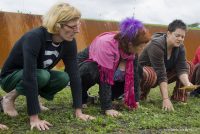Last month, I had the chance to visit the Windward Education and Research Center, an intentional community in rural Washington, for an event called the EcoSex Convergence. Over 5 days, 150 participants explored topics related to environmentalism, spirituality, sexuality, and more.
The event’s guests of honor were Annie Sprinkle and Beth Stephens, who combine academic research and performance art to ask questions like: What would it be like to treat the earth as a partner? To ask for consent from nature before engaging with it? To remember than humans are part of the ecosystem too?
“By shifting the metaphor from ‘Earth as mother’ to ‘Earth as lover’ we aim to entice people to develop a more mutual, pleasurable, sustainable, and less destructive relationship with the environment.”
Their documentary Goobye Gauley Mountain ties these threads together to tell an “ecosexual love story” as they join with other activists to protest mountaintop removal in West Virginia. It was incredible to hear their story while camping out on land of a very different kind, in a community that puts these ideals into practice.
Shifting Windward
Originally envisioned as a sea-based community in international waters in the Carribbean, the founders of what is now the Windward community relocated to rural Washington in 1988. They believed that while exploring permaculture in warmer climates might do some good, they could have the biggest impact by creating systems on marginal lands that are less suitable for growing crops.
Just 80 miles outside of Portland, the community has learned to live alongside the high winds, dry soil, and cold winters of Klickitat County, Washington. With 7 permanent members, as well as some interns and short-term residents, they use experimentation and collaboration to move toward greater interdependence and resiliency. Each member is expected to contribute to work parties and to bring in $400 worth of income – from either independent work or on-site projects – each month.
The group’s flagship project is Biomass2Methanol research, which uses open-source technology to turn biomass (such as wood or chaff) into compressed methanol. The gas can be used to power vehicles, generators, and tools that would otherwise require propane or electricity. The research is funded by donations and will be available for other communities to use and to build on.
Another major project at Windward is the Herland Forest Natural Burial Cemetery, which takes a long-term view of the role that death plays in the ecosystem. One benefit of developing a cemetery on the land is that people buried there can serve as “Guardians” of the forest for future generations:
“Operating a cemetery in a forest creates enduring restrictions on the use and development of the land – helping ensure that the ecosystem’s vitality remains intact…. Guardians protect the life of Herland Forest when they lay their bodies down amidst it’s trees.”
From my short visit, I got the sense that Windward is a community doing many things right. By abiding by local land use codes and paying off all its debts, it’s setting itself up to be a long-term model of sustainable living. It will be exciting to see how things shift as newer members bring more projects and ideas to life!
****
Want to learn more about the Windward Community? Follow their Facebook page or check out their website to find out about internships, permaculture gatherings, open houses, and other activities. Learn more about ecosexuality by watching Annie and Beth’s documentary on Netflix or their interview with KQED below:
Photo by Melania Fraga.





















